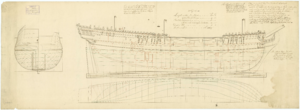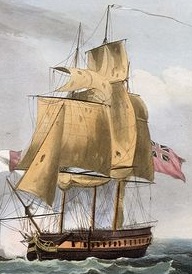HMS Trent (1757) facts for kids

Trent
|
|
Quick facts for kids History |
|
|---|---|
| Name | HMS Trent |
| Ordered | 5 May 1757 |
| Builder | Woolwich Dockyard |
| Laid down | 19 May 1757 |
| Launched | 31 October 1757 |
| Completed | 23 November 1757 |
| Commissioned | September 1757 |
| Fate | Sold to be taken to pieces at Portsmouth 26 January 1764 |
| General characteristics | |
| Class and type | 28-gun Coventry-class sixth-rate frigate |
| Tons burthen | 587 30⁄94 bm |
| Length |
|
| Beam | 33 ft 8 in (10.3 m) |
| Depth of hold | 10 ft 6 in (3.20 m) |
| Sail plan | Full-rigged ship |
| Complement | 200 officers and men |
| Armament |
|
HMS Trent was a 28-gun frigate of the Royal Navy, built in 1757. Frigates were fast, medium-sized warships used for scouting, protecting convoys, and attacking enemy ships. Trent was part of the Coventry-class of ships.
Contents
Building a Warship: HMS Trent
Trent was one of five ships in her class built from fir wood instead of the usual oak. Fir was cheaper and easier to get, which meant ships could be built much faster. However, ships made of fir usually didn't last as long as those made of oak. The four fir-built Coventry-class ships that weren't captured lasted only about nine years on average.
How Ships Got Their Names
The ship was named after the River Trent, which is the third-longest river in England. The British Navy often named ships after places like rivers, regions, or towns. This tradition started way back in 1644. Many other ships in the Coventry-class were also named this way. Some ships were named after figures from ancient Greek and Roman stories, a trend that became popular in 1748.
What Made Trent Special?
Trent was designed to be similar to French frigates of its time. It had a strong, shorter hull and carried heavier guns. It was also quite wide, which meant there was plenty of space for food, supplies, and the crew's living areas. It had a large magazine to store gunpowder and cannonballs.
These features allowed Trent to stay at sea for long periods without needing to return to port for supplies. It also had strong, wide masts, which helped the ship stay stable in rough seas and carry more sails. The only downsides to this heavy design were that it made the ship a bit slower and harder to steer in light winds.
Who Was On Board?
Trent was designed to have a crew of 200 people. This included two main officers: a captain and a lieutenant. Below them were 40 warrant and petty officers, 91 regular sailors (called naval ratings), 38 Marines, and 29 other crew members, including servants.
HMS Trent's Adventures at Sea
On January 5, 1761, Trent was sailing about 10 leagues (about 30 miles) off Cape Tiburon. It came across a French merchant ship called Bien Aimé. This ship had 20 guns and 85 men and was on its way to Martinique.
Trent fought Bien Aimé in a single-ship action, which means a battle between two ships. Trent won the fight and captured Bien Aimé. During the battle, Bien Aimé had 40 men killed or wounded. Trent had one man killed and five wounded.


